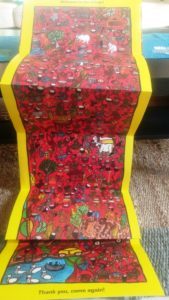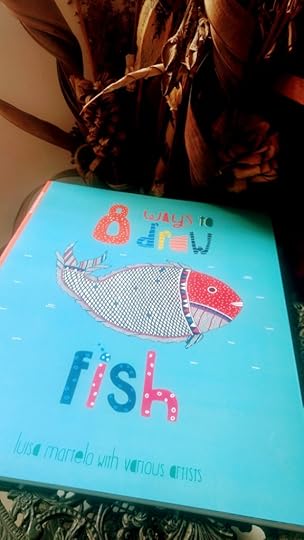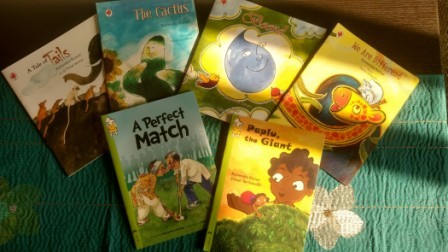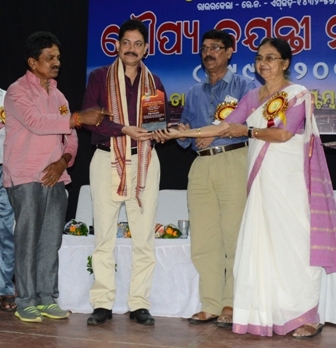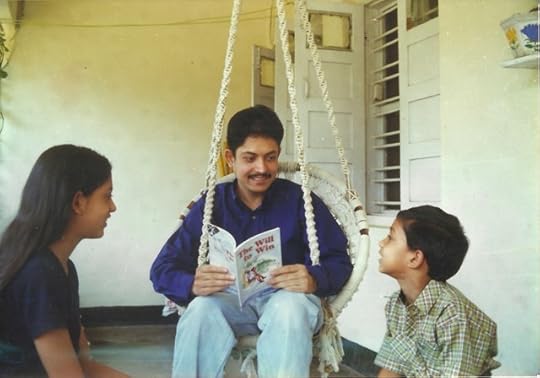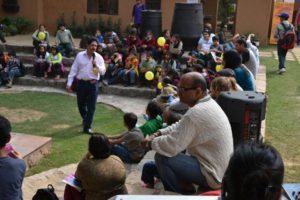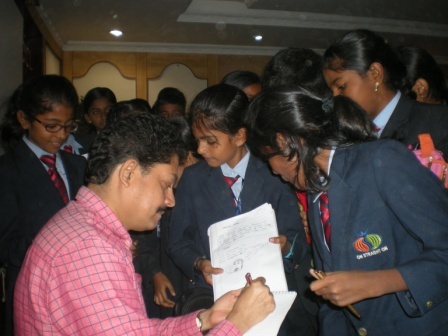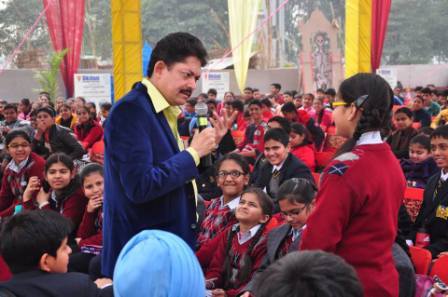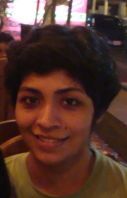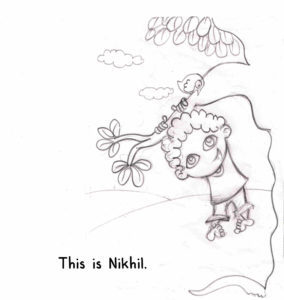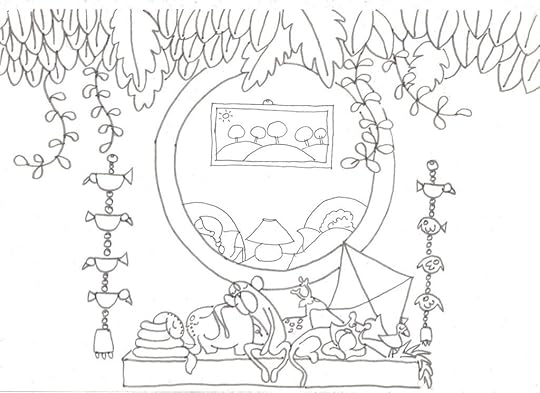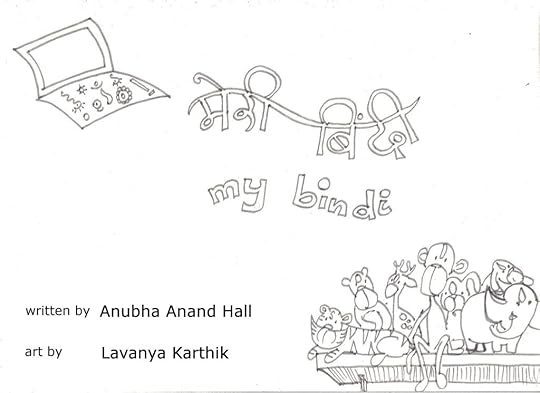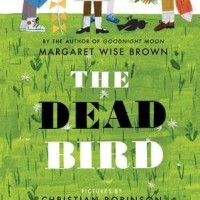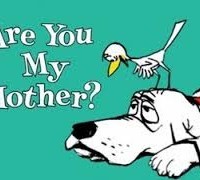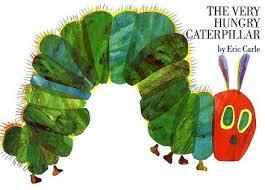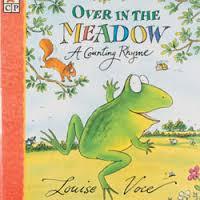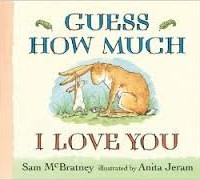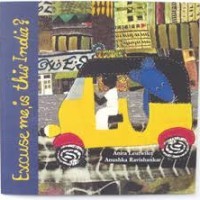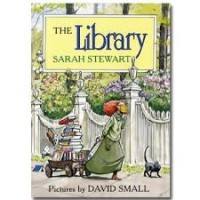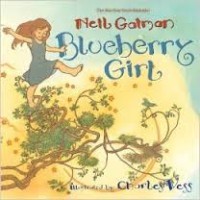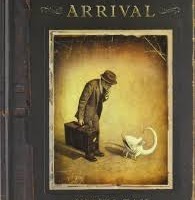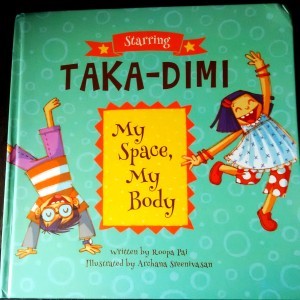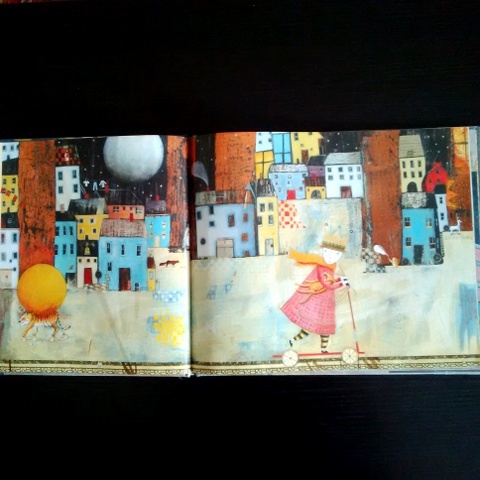Richa Jha's Blog: Snuggle with Picture Books
February 7, 2017
Two New Tara Books Beauties!
I am a proud, compulsive collector of books from Tara Books. And so, when these new releases arrived in the courier last week, I could barely contain my joy!
Done in Bengal’s Patua style folk art, A Village is a Busy Place! is a quintessential Tara collectible; every bit as artistically thought-through, aesthetically executed and quirkily conceptualized. It opens out as a scroll unraveling, fold by fold, a busy Santhal village and its bustling life over the course of the day or across seasons. Each fold shows a cross section of the village accompanied by an engaging commentary by V. Geetha. Her words give excellent pointers to the reader to look for specific information and tease out a lot more through questions. For instance,
‘Spot the man and woman holding up cones of peanuts! Are some people getting ready to go somewhere?’
Working my way through the intricate filigree-like latticed web of exquisite hand-painted humans, animals, huts and pots and pans by Patua artist Rohima Chitrakar, it took me a minute or so to locate the two with peanuts! But in the process, I discovered so many other interesting details that lay hidden in the deeply rich and intricately done illustrations. The book is outstanding in that way.
My favourite page is the one titled ‘Summertime’. Ms Chitrakar’s impression of the train is delightful. I’m being a bit of a tease by not showing you what it looks like, though!
That is also why you cannot cursorily skim through this book. The artwork is busy, vibrant and incredibly detailed. Its organic feel will make you want to hold it close to you to smell the earth, the fish and the pots filled with the village produce. Staying close to the traditional style of this art form, the artist uses just a handful of naturally appearing colours to paint this joyous village scene against a blazing red backdrop. Each person depicted has a distinct personality (look carefully at the eyes) and together they make a charming snapshot of a vibrant community life.
The book throws the spotlight on way of living vastly different from what most of the children in urban India (or internationally) are familiar with. Though not a Santhali myself, I come from a small town in the Santhal region of East India. But having moved away decades ago from this town where I grew up, I feel sheepish admitting that the village depicted in this book is as alien to my children as it will be a child reading it in New York. And it is only when we pick up such books for our kids do we realize how crucial it is to explore more of these together.
A Village is a Busy Place! is a riveting activity book which makes for an equally mind blowing painting or hangable art; it’s a Patua scroll, after all! It will keep you and your child hooked for hours. And some more, when you sit with it the next time. And the next.
8 Ways to Draw Fish, along the lines of the earlier release 8 Ways to Draw Elephant, is a great non fiction colouring book to introduce some of India’s most celebrated folk and tribal art styles to children. Culturally, the fish holds an important and often auspicious place in our traditional rural milieu. And each art form has its own way of depicting it. Therefore, it is befitting that a book be dedicated to it in all its glory!
Quoting from the media brief: ‘Through tracing, patterning and colouring differently shaped fish and the water they swim in, children learn to explore each of the distinctive art traditions in the book – or just have fun. They also get to experience and understand how art is as much about the imagination as it is about depiction.’
Beautifully designed by Luisa Martelo from Porto / London, this activity book will appeal equally well to adults. I love the way the book introduces the concept of art – beginning from how an object looks like in real life, and what it may finally appear as through an artist’s reinterpretation. And also, that each artist will have her/ his own distinctive impression of the same object, even when operating under the same broader art-form and cultural influences. Indeed, as the second page of the book points out, there are infinite ways of drawing something as simple as water!
It’s a nice big sturdy book. Illustrated by various artists, the different art forms depicted in this book are the tribal art forms of Meena, Gond and Bhil alongside the Madhubani and Patua folk styles. The text accompanying the illustrations is packed with the kind of trivia children itch to lay their hand on! Not to forget the engagingly designed covers, both outside and inside, by Catriona Maciver; it’s a complete visual feast in itself!
November 21, 2016
Author Ramendra Kumar on writing, his critics and his inspiration
I have the pleasure of sharing this most delightful exchange of questions and replies with one of India’s most recognisable and loved children’s authors, Ramendra Kumar (Ramen). He is a national award winning writer and the author of over 30 books for children and adults. Ramen’s writings have been published in 12 Indian and 10 foreign languages. His stories, poems and satires have found a place in text books, as well as national and international anthologies including the popular ‘Chicken Soup for the Soul Series’. Six of his books have been recommended by Central Board of Secondary Education (CBSE), as Supplementary Readers. One of his Read Aloud books Paplu The Giant was selected to mark the International Literacy Day in September, 2013. He has held more than a thousand story telling sessions in 25 languages across the country as well as abroad. His latest book A Perfect Match has been picked up by Andhra Pradesh government for placement in 11,200 schools in all the districts of the State.
Ramen has been invited to different forums as an inspirational speaker and a storyteller both in India and abroad. To know more about the writer you can visit his website: www.ramendra.in or check out his page on Wikipedia. An Engineer and an MBA, Ramen is the Chief of Communications at Rourkela Steel Plant, Odisha.
Let me tell you, I was in splits going through his e-response to my questions! I am sure you will be, too.
RJ: Congratulations on the recent Sankalpa Samman honour, Ramendra! Tell us something about this award.
RK: I was awarded the Sankalpa Samman for my contribution to literature, on 27th September, 2016. The award was conferred by Sankalpa, a premier cultural organisation of the region, on the occasion of its silver jubilee.
RJ: When did you start writing for children?
RK: I started writing satire, poetry and fiction in my college days and continued my literary pursuits after I joined Rourkela Steel Plant. My creative endeavours received a modest degree of success.
When my daughter Ankita was four, my son Aniket happened. My wife Madhavi is working in the same Steel Plant as I am. Her hands were naturally full taking care of the new born.
“You write satire and poetry, don’t you?” Madhavi told me one day. “Then why can’t you tell Ankita stories and put her to sleep, while I concentrate on Aniket?” To her, shifting from satire/poetry to children’s fiction was as simple as moving from the universe of boiled eggs to that of poached eggs!
Anyway, I seriously took up her advice and started thinking up little tales to tell my precious one. I don’t know whether she liked the plot more or my antics, but she lapped up my stories and my confidence increased. Soon it became a tradition which continued even after Aniket grew up and doubled the size of my audience. The stories liked by my kids found their way to the laptop and from there to the publisher’s desk. The tales started getting published and thus began my journey into the idyllic world of children.
(with Ankita and Aniket when they were younger)
RJ: We’d love to know something about your first book.
RK: My first book was a collection of ten value based stories called Just a Second and other Stories.
There is an interesting incident associated with the eponymous story in this collection. When my daughter Ankita was five, I was invited to her school to address the students. I thought instead of giving a speech let me tell a story and wrote ‘Just a Second’. It was about seven brothers, the youngest named Second and the eldest Year. It stressed upon the value of time.
I told the story in the school assembly. The response from the kids was wonderful. They simply loved it. In fact, when my wife and I went to a teacher’s house six months later she told me something which left a deep impression on me.
“Mr. Kumar, the story you told that day had a great impact on the kids. Just the other day when I was telling my students how important hygiene was, one of them asked, ‘Is it as important as the Second, ma’am?’ I looked at him with a puzzled expression on my face, not comprehending.
‘That day an Uncle had come and talked about the importance of Second’, he explained and only then I understood. I had forgotten, but your story seems to have left an indelible impression on the young minds.”
Needless to say, I was thrilled!
(at the Chandigarh Children’s Literature Festival)
RJ: That is such a delightful story by itself, Ramendra! I am sure the children gain a lot from your sessions. Anything equally interesting, if not more, about your latest book?
RK: My latest book which will be released next month is titled A Naani called Tsunami. It is a tale of a 62 year old grandma who is loaded with infectious enthusiasm, unbridled energy and an unconventional take on life. The books are a tale of camaraderie and commitment, guts and gumption, laced with oodles of masti. What should make the book an endearing read, I feel, is the connect between the gen ex and gen next. The book is value driven but not preachy, its tone is sensitive but not maudlin; it takes up issues of concern without snapping the gossamer web of humour.
RJ: A Naani Called Tsunami sounds like a lot of fun, Ramendra! Looking forward to reading it. Which brings us to something that a number of readers and your fans would love to know: when and how do you create time for writing alongside full time employment and family and home?
RK: I firmly believe that time is a function of your PQ or Passion Quotient. If you have the passion for something, you’ll find the time for it.
I am really, really passionate about writing. I hardly socialise nor do I go for booze sessions with colleagues or friends. I go to the club only for swimming in summers. My tryst with the idiot box is limited to the news or the odd sports event. So, it is basically me, my family and my writing.
Madhavi, my wife, has been a big support since she handles many of the daily chores leaving me to my obsession.
A writer, someone said, is never unemployed. Even when he/she is looking out of the window he/she is ‘on the job’. The same thing holds true for me. In meetings and at the social gatherings where I am forced to go, I simply switch off. I have cultivated the art of sporting the right expression on my face during dull conversations so that the speaker gets the impression that I am all ears, whereas actually I am miles away in my own sanctuary of plots, characters and milieus!
I haven’t tried this with Madhavi, when she extols the virtues of her mother, for fear of getting beaten up!
(RJ: Hahahahaha, you’d better not!)
Another aspect which helps me is my ability to ‘file’ stories in my head. Once an idea comes to my mind I keep nurturing and nourishing it till a complete story is formed. Many times the story stays with me for days, weeks, sometimes even months. This helps me a lot since I can plot when I am otherwise occupied and key-in the stuff when I have the time and access to my laptop.
(Bookaroo, New Delhi)
RJ: What are your sources of inspiration for children’s books?
RK: Like I have mentioned, my biggest sources of inspiration have been my own kids. A few of my most popular stories are based on the comments made by my children.
While spinning my yarns, the biggest challenge was matching their completely divergent tastes. While Ankita loved the ‘once upon a time…and they lived happily ever after’ tales of pretty princesses and handsome and daring princes, Aniket my in-house Rambo, whose guru was Bruce Lee, wanted unadulterated action – the gorier the better. The ‘sleight of mind’ I indulged on a ‘nightly’ basis to ensure the delight of my esteemed ‘customers’, I am sure, sharpened by literary skills and helped me become a more effective writer.
Then again, a large chunk of my work owes its existence to my imagination (brilliant to me and weird, wild and wacky to Madhavi!)
RJ: Ramendra, by now I am totally cracking up! So are the readers, I’m sure. And someday, I’d LOVE to interview Madhavi to hear her side of the story! Coming to our next question. By now, we kind of know the answer, but we want to hear it from the horse’s mouth: Who is your biggest critic?
RK: Ankita and Aniket have been my greatest fans and harshest critics. Aniket was the more ‘in your face’ of the two. He had only two words to critique my tale – Chaat or Mast! Chaat meant it had to be trashed and Mast indicated the tale was to be sent pronto to the publisher. Luckily the number of ‘Mast’ were far, far more than the number of ‘Chaat’ and hence I could notch up a healthy score of 30 books.
RJ: 30 is sooooper suberb; and you have all our wishes for a 130 more! How do you find the process of interacting with children during your author visits? What are some of the interesting things kids ask you?
RK: When I’m in the company of kids I feel much younger and far more vibrant. Even a few minutes with little hearts and souls are like an injection of elixir. Will it be too immodest to say that I look much younger than my age because I spend so much time in the pristine world of children?
(RJ: Not at all! We hope you continue to spend more and more time with the bachchas and look the way you do now all your life!)
The response of the young has been fantastic to my initiatives. In some of my workshops the strength has been nearly 400 while the ideal for this kind of an event is considered to be around 50. My sessions usually involve a lot of singing and dancing; I am terrible singer and a terrific dancer (RJ- sorry for butting in here, but we’re having a swell time discovering the Ramendra behind the books!) After the workshops the children have often mobbed me with their slam books, class copies and even pieces of paper, asking for autographs. I have felt like a rock star and prayed that time, for a change, wouldn’t play spoil sport.
(at Coimbatore)
In one school a ten year old child came up and told me, “Uncle, this was the happiest day of my life!” Another little girl unleashed an affectionate instruction, “Sir you have to come to our school once every month!” At Bookaroo, a boy told me, “Hello Sir, my dream was to be a story writer. You helped me a lot. Can we become email friends?”
I have been deluged with questions related to ideation, plots, locales, how I write, why I write, the place I write, which is my favourite story, my most endearing character et al.
(Chandigarh)
RJ: So truly heartening to read this, Ramendra. May you keep inspiring children with your words and infectious enthusiasm forever and ever. On a slightly unrelated note, are your characters reflections of you or your children in one way or another?
RK: Yes, in a few stories the hero does have shades of my persona as a child. In couple of tales have I modeled the protagonists on my children.
RJ: Hmmm…that’ll have a lot of your readers guessing! What are you working on these days?
RK: I am working on two books. I have been commissioned to write a ‘graphic book’ on the Juvenile Justice Act, for children. I am also writing a novel for tweens in which the protagonist Ghatotkachha is banished from heaven. The book recounts the misadventures of Bhima’s son as a normal 12 year old in ‘Mera Bharat Mahan!
Wishing you the very best for everything, Ramendra, and we look forward to reading many many more fun books from you. A big thanks for taking time out for this.
May 31, 2016
Author Anu Anand talks about her book Meri Bindi
Meri Bindi, by Anu Anand and Lavanya Karthik (Hachette India) is a new Hindi – English bilingual release with a difference – apart from the usual two lines in the respective languages, we have an additional third line to help with the Hindi pronunciation. Aimed at 0+, Anu Anand’s lucid text is short, crisp and playful, and the premise is charming. Lavanya Karthik’s exuberant paper cut art work is gorgeous. An overall winsome combination!
Which is why I’m thrilled to present these interviews with the creators of this book! (See Lavanya Karthik’s here).
(image source: http://anuanandjournalist.com)
Author Anu Anand is a journalist with BBC World Service Radio, and splits her time between New Delhi and London. I took the liberty of deleting several endearing personal bits from her bio on the press release because much of it seeped into this interview in a lot more intimate way. (For loads more on her, hop across to her website.)
Anu, a warm welcome!
RJ – Did you have the Indian diaspora in mind while coming up with the idea for this book?
AA – Yes, initially. The Indian diaspora is gargantuan and spread right around the world, from the far-east, Australia, Africa, Russia, the middle east, Europe and North America. Indeed, I’m part of it, as my parents left India for the US when I was a year old. I certainly wanted to create something that would be useful to parents of very young children living anywhere, struggling to pass on their language. But to my surprise and delight, I’ve found that the audience is not limited to the diaspora. So many foreigners are now married into Indian families, are half-Indian themselves, are living or working in India or visiting, and are generally interested in the culture and language. The world is still very limited in terms of bilingual resources. I’ve searched far and wide, and outside of Tulika in India (which most NRIs and foreigners may not have access to), the only bilingual resources tend to be English-French, English-German, English-Spanish and very occasionally, English-Mandarin. And these are generally translations of the same three or four fairly-tales (The Three Little Pigs, Little Red Riding Hood, etc). There are far too few original bilingual Hindi-English picture books aimed at young children, which seems crazy, given the need.
RJ – The second line of the text on each page is a novel concept in Indian picture books. Why did you feel the need for it?
AA – Meri Bindi was inspired by my own struggles as a parent to pass on my mother tongue to my son and daughter (now 7 and 4).
I grew up in the US with Hindi speaking parents who insisted I use the language at home. Thanks to them, I still speak Hindi fluently and can read and write it — albeit slowly. I had in mind friends and family in the US, many of whom are now parents themselves. They grew up speaking Hindi but never had the opportunity to learn formally. Still, they highly value Hindi and want to pass it on. I wanted my book to be accessible to them, so I added a line of phonetic Hindi. After I started to show the book around, many non-Hindi speaking foreigners told me they loved this idea too, as they wanted to engage in the language of their adopted home, and couldn’t find any resources.
After my son was born, I really struggled to get him to speak Hindi. At first, I naively thought that simply by living in India, my kids would pick up the language by osmosis. But I quickly discovered that I had to actively and consistently use it with them to have any impact. Researchers now say language forms in the first six months of life — indeed, I can see this with my kids. My son came to India at the age of 18 months and still struggles slightly with Hindi sounds. My daughter was there from the first few weeks of life and sounds totally native. One golden opportunity for us to use Hindi inevitably came at bedtime, when children are ripe for books and stories. But at the end of a long hard day, I’d struggle to spontaneously translate English books, or my kids would reject the change in language outright. So I decided to come up with my own book, featuring a simple, imaginative story. Key to my vision was that the book should have rich, original and hand-made (not computer generated) illustrations. I was extremely lucky to find the amazing Lavanya Karthik. Her cut-paper illustrations have turned Meri Bindi from 15 simple lines of text into a whimsical story, exquisitely visual, with many many objects on each page that parents and children can name in Hindi.
RJ – a resounding aye aye to that, Anu! Here’s a fab interview with Lavanya on her take on this book. Moving on, how will the book be positioned – as a read alone by a child or a read aloud by a parent/ caregiver?
AA – Publishers will have more expertise on the physical positioning on bookstore shelves, but as a parent, I value the book’s flexibility. Of course an adult can read the text out loud using the Hindi or phonetic text. But even older children learning to write in Hindi for the first time can use it, as well as non-native speakers. Children are so imaginative, hand almost any of them a book, and they’ll narrate a story without being able to read a word. I didn’t want the book to be obviously about learning language. The idea was to show them a world related to Hindi – featuring Indian characters, animals and scenes — that were so fun they’d use Hindi because they wanted to, not because they were being made to. And I wanted parents to enjoy the experience of diverse books, different from the usual western settings in which mostly middle-class, white children with Christian names feature. The world is so much bigger and wider, why shouldn’t children’s books reflect that?
RJ –What are the other books in this series?
AA – The idea of the series is to introduce more basic words in Hindi so I’ll be using more simple settings and sentences to do that, with Noor, Neel and Moochhar Singh all featured in each book. I have a list of ideas as long as my arm and as my children grow, the need for material also grows, so the series will only be limited – I hope – by popular demand!
RJ – Amen to that, Anu! Why bindis? Are you fond of wearing them?
AA – Who’s not fond of them?! Let’s face it, bindis are one of India’s most unique exports — they are tactile, visual and fun! I saw a group of 2 year olds responding to an adult handing out bindis and that was the moment I thought it would be a brilliant vehicle for a picture book.
RJ – How much of your own children do we see in Noor and Neel?
AA – My kids don’t play as nicely as Noor and Neel!! But both my kids – like Noor, Neel and children everywhere – are brimming over with imagination. So when Neel puts the red bindi on his nose like a clown, well, that’s exactly what my son might do. And that’s where Lavanya’s talent shines through — not just in the literal rendering of images, but in weaving elements I’d thought up randomly to create characters, places and a story that has become so much bigger and more imaginative than a red dot on a forehead!
RJ – I love the way the animals have been paired with the type of bindis. Were they a part of your manuscript or did Lavanya come up with those?
AA – This was entirely Lavanya’s genius. Lavanya did as much to create this book as I did. Her work made me realize just how central illustrations are to books and how vital it is to work with a creative and passionate illustrator to get the book right. I was extraordinarily blessed to find her and truthfully, her illustrations pushed me to take what began as an amateur personal project to a book that’s actually in print.
RJ – As a journalist with BBC World Service Radio, you’re used to playing and dealing with words all the time. How different was the experience of writing a picture book?
AA – If I told you that writing a children’s picture book has made me a better broadcaster, you’d probably laugh. How can simplistic sentences about bindis have any bearing on relating complex global events? But in truth, different forms of communication boil down to respecting and engaging your audience, and picture books are actually a more complex medium than live radio. Children have a lot to teach us about effective communication. You don’t need big words, long sentences or complex grammar to explain things. Creating this book was definitely a literal lesson in one of journalism’s most basic and cherished objectives: ‘show, don’t tell.’ It’s a great rule to work by whether creating a picture book, or explaining the Syrian civil war.
RJ – And finally, which of the bindis in the book is your favourite?!
AA – That’s the toughest question I’ve been asked so far…! If vanity prevails, then it’s Chanda-Mama’s bindi because it’s so classically gorgeous. Otherwise, it’s a three-way tie: I love the banana bindi for its sheer cheekiness, the snake’s bindi because how cool is that?? And if you look on the cover (or on the vocabulary page) you’ll see that the fish is wearing bubbles as bindis… that image sums up for me the endless charm and genius of bindis: they are only limited by our imagination!
Anu, what a pleasure it’s been talking to you! Readers, she did this email interview while she was bang in the middle of moving house. With every email exchange, I could picture her sitting amid a bunch of half open cartons and (if she’s anything like I am) stuff strew all over, reading out Meri Bindi to her children! Wishing you many more titles in this series.
For details of the book, click here.
Lavanya Karthik on illustrating Meri Bindi
When Meri Bindi landed on my desk, I was immediately taken in by illustrator Lavanya Karthik’s distinctive art work. Which I when I decided to get it all straight from the horse’s mouth. (You can read the interview with the book’s author, Anu Anand, here.)
Lavanya Karthik lives in Mumbai, where she writes, draws, daydreams and eats way too much chocolate. For more awesomeness, visit her website and her Facebook page.
RJ – I love the paper cut artwork. Is there a special name for this technique? How did you decide to do this book this way?
LK – ‘Cut Paper Art’ would describe it best.( I know a lot of people would call it ‘collage’, but I associate that term with a mix of media, textures and materials). It’s a style I love working in, and even used in my first book (What does Anu see? for Pratham) but it wasn’t the first choice for the book at all. The illustrations for Meri Bindi were first visualized in watercolour. But midway through the process of making them, I realized they would look far better in cut paper.
RJ – Were the animals corresponding to each of the bindis pre-decided by the author, or did you bring in your ideas?
LK – The story behind the illustrations, and the characters in them, developed gradually, with each version of the spreads. In fact, the very first version only starred a bunch of little kids with bindis on. By version 4 or so, however, this sweet little story emerged, that works wonderfully in tandem with the text. Anu and I were constantly exchanging ideas and suggestions for the spreads, adding pages, and so on.
RJ – There are two spreads in particular, the first two, that have vivid backdrops. One is a cityscape while the other is the room where Noor and Neel are playing. Any specific personal influences for both?
LK – The cityscape was actually the last spread made, and was Anu’s idea entirely, to introduce the characters and the very Indian environment they live in. I love a picture brimming with detail and colour, and cut paper art is perfect for that – it is a great way to build layers in an illustration, letting you add details as you go along.
RJ – How many packets of bindis did you end up buying before settling on the ones that you finally feature in the artwork?!
LK – Not too many, but only because I am always knee deep in craft supplies and stick-on bling anyway!
RJ – Can the readers have a sneak peek at your work station?!
LK – Let me describe it instead….. I have a huge, airy, sun-drenched studio space in the middle of a beautiful pine forest, with floor to ceiling windows offering me spectacular views of the Himalayas. Sadly, it only exists in my head because I live in a tiny flat in Mumbai, hemmed in by buildings on all sides, with spectacular views of parked cars, delivery vans and washing lines. In the real world, my workspace is a 25 year old fold-down drawing board in one corner of my daughter’s room, covered in coffee cup rings, ink stains, ancient games of noughts and crosses and the odd to-do list.
RJ -Someday, we’ll extract a pic of this yummy workstation out of you, Lavanya! Just as we managed to get glimpses of the WIP! Thank you for sharing these with our readers! It’s been a delight chatting with you. Wish you many many more fun projects and wow books!
March 17, 2016
Death and Moving On in Picture Books
I was drawn in by two recent online posts about picture books dealing with death, and coping with the inevitability of this form of loss:
Cry, Heart, But Never Break: A Remarkable Illustrated Meditation on Loss and Life
Cry, Heart, But Never Break (by Glenn Ringtved and Charlotte Pardi; translated by Robert Moulthrop; Enchanted Lion) at Brainpickings, about the heartwarming depth of close familial bonds when played against the existential impermanence of life, and
The Dead Bird by Margaret Wise Brown
The Dead Bird (by Margaret Wise Brown and Christian Robinson; Harper) at Waking Brain Cells, about the similar impermanence of grief for the loss of a dear one, as our mind has developed its own coping mechanism by moving on after a while. I’ll be hunting high and low for both!
Below are 15 of the most moving picture books I’ve read on a subject that is difficult to talk about with children who are yet to face a loss of this nature. And for those who have lost a dear one, these books offer ways to deal with the shock and grief. In no particular order of preference:
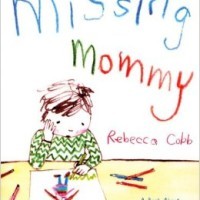 Missing Mommy
(Rebecca Cobb; Henry Holt And Company): A little boy learns to deal with his mommy’s death. From not knowing where she has gone, to dealing with overwhelming emotions, to understanding what death means (his dad ‘said that when someone has died they cannot come back because their body doesn’t work anymore’), to coming to terms with the realization that he won’t see her ever again, to finding comfort within his family by keeping Mommy’s memories alive and doing things together, this book has a nuanced, gentle take on this difficult subject.
Missing Mommy
(Rebecca Cobb; Henry Holt And Company): A little boy learns to deal with his mommy’s death. From not knowing where she has gone, to dealing with overwhelming emotions, to understanding what death means (his dad ‘said that when someone has died they cannot come back because their body doesn’t work anymore’), to coming to terms with the realization that he won’t see her ever again, to finding comfort within his family by keeping Mommy’s memories alive and doing things together, this book has a nuanced, gentle take on this difficult subject.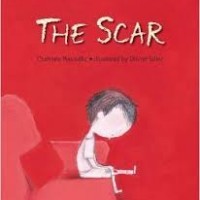 The Scar
(by Charlotte Moundlic and Ollivier Tallec; Candlewick): A heart wrenching narrative, laced with graceful humour, of a child grieving the loss of his mother. “I’m trying not to forget what Mom smells like, but it’s fading, so I close all the windows so that it won’t get out.”
The Scar
(by Charlotte Moundlic and Ollivier Tallec; Candlewick): A heart wrenching narrative, laced with graceful humour, of a child grieving the loss of his mother. “I’m trying not to forget what Mom smells like, but it’s fading, so I close all the windows so that it won’t get out.” The Heart and The Bottle
(by Oliver Jeffers; Philomel Books): An utterly heartbreaking gem from Jeffers on a girl’s response to the loss of her father. The girl standing by the empty sofa will cling to you, you’ve been warned.
The Heart and The Bottle
(by Oliver Jeffers; Philomel Books): An utterly heartbreaking gem from Jeffers on a girl’s response to the loss of her father. The girl standing by the empty sofa will cling to you, you’ve been warned.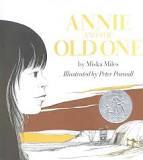 Annie and the Old One
(by Miska Miles and Peter Parnell; Little, Brown and Company): A poignant and reflective classic about a Native American girl coming to terms with the approaching death of her grandmother. She does everything she can to stall it only to understand that she cannot ‘hold back time.’
Annie and the Old One
(by Miska Miles and Peter Parnell; Little, Brown and Company): A poignant and reflective classic about a Native American girl coming to terms with the approaching death of her grandmother. She does everything she can to stall it only to understand that she cannot ‘hold back time.’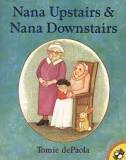 Nana Upstairs and Nana Downstairs
(by Toamie dePaola; Puffin): A book I never tire of going back to. Despite talking of the loss of not one but two most-dearly loved grandmothers, the book makes you smile through your wet eyes at the end. It’s gentle, it’s uncomplicated, and it’s matter-of-fact, peppered with vignettes slice-of-life humour which stay with you forever.
Nana Upstairs and Nana Downstairs
(by Toamie dePaola; Puffin): A book I never tire of going back to. Despite talking of the loss of not one but two most-dearly loved grandmothers, the book makes you smile through your wet eyes at the end. It’s gentle, it’s uncomplicated, and it’s matter-of-fact, peppered with vignettes slice-of-life humour which stay with you forever.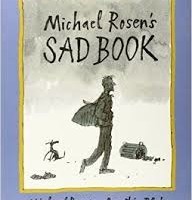 The Sad Book (by Michael Rosen and Quentin Blake; Candlewick Press): A moving personal account of a father grieving, enveloped in melancholy, and coming to terms with the loss of his son.
The Sad Book (by Michael Rosen and Quentin Blake; Candlewick Press): A moving personal account of a father grieving, enveloped in melancholy, and coming to terms with the loss of his son.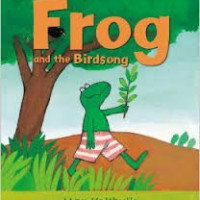 Frog and the Birdsong
(by Max Velthuijs; Andersen): One of the best books for toddlers and young ones to talk about the inevitability of death and the beauty of life. And that there’s grief in death, even if it’s a stranger’s. Sweetly, lovingly, calmly told.
Frog and the Birdsong
(by Max Velthuijs; Andersen): One of the best books for toddlers and young ones to talk about the inevitability of death and the beauty of life. And that there’s grief in death, even if it’s a stranger’s. Sweetly, lovingly, calmly told.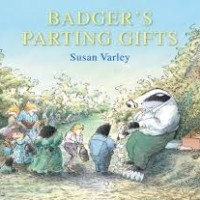 Badger’s Parting Gifts
(by Susan Varley; Magi Publications): This story both gets my throat all lumpy and never fails to bring a smile. A most tenderly told and illustrated moving story of impending death, learning to deal with loss, and finding pleasure and meaning in one’s life through what the departed being has left behind. Look at how gracefully this ends – ‘Whenever Badger’s name was mentioned, someone remembered another story that made them all smile.’ Lasting legacies, we say.
Badger’s Parting Gifts
(by Susan Varley; Magi Publications): This story both gets my throat all lumpy and never fails to bring a smile. A most tenderly told and illustrated moving story of impending death, learning to deal with loss, and finding pleasure and meaning in one’s life through what the departed being has left behind. Look at how gracefully this ends – ‘Whenever Badger’s name was mentioned, someone remembered another story that made them all smile.’ Lasting legacies, we say.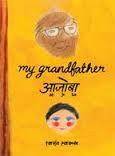 My Grandfather Aajoba
(Taruja Parande; Tulika): Taruja collates snatches of the vivid memory of her Aajoba, his photographs, his words, scraps of paper, articles, other items that remind her of him, and decorates them together in the form of this book. It’s the kind of scrapbook you and I have always wanted to make of people who mean the world to us, but have never got around to doing it. It’s a loving grand daughter’s way of saying, ‘I miss you Aajoba.’
My Grandfather Aajoba
(Taruja Parande; Tulika): Taruja collates snatches of the vivid memory of her Aajoba, his photographs, his words, scraps of paper, articles, other items that remind her of him, and decorates them together in the form of this book. It’s the kind of scrapbook you and I have always wanted to make of people who mean the world to us, but have never got around to doing it. It’s a loving grand daughter’s way of saying, ‘I miss you Aajoba.’ Goodbye Mousie
(by Robie H Harris and Jan Ormerod; Aladdin): Accepting a loved one’s death is the first step in the healing process, as we find the young boy going through a range of strong emotions – denial, anger, sorrow, and struggling to come to terms with his pet’s loss. The most moving part of this book is when he decides to leave a part of himself in the funeral box that he prepares for his Mousie.
Goodbye Mousie
(by Robie H Harris and Jan Ormerod; Aladdin): Accepting a loved one’s death is the first step in the healing process, as we find the young boy going through a range of strong emotions – denial, anger, sorrow, and struggling to come to terms with his pet’s loss. The most moving part of this book is when he decides to leave a part of himself in the funeral box that he prepares for his Mousie.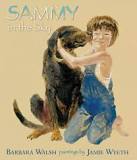 Sammy in the Sky
(Barbara Walsh and Jamie Wyeth; Candlewick Press): Sammy is a young boy’s pet hound dog with whom he is until his final feeble breath. This is the only book where I’ve seen a child seeing a beloved pass on. ‘As the summer days grew shorter, my chest stopped hurting when I thought of Sammy.’ Somewhere towards the end of this book come these words that make your heart both ache and soothe. They tell you of the inevitability of the memories fading away, bit by bit, in this never-ending cycle of life and death. But equally also, of the healing power of memories.
Sammy in the Sky
(Barbara Walsh and Jamie Wyeth; Candlewick Press): Sammy is a young boy’s pet hound dog with whom he is until his final feeble breath. This is the only book where I’ve seen a child seeing a beloved pass on. ‘As the summer days grew shorter, my chest stopped hurting when I thought of Sammy.’ Somewhere towards the end of this book come these words that make your heart both ache and soothe. They tell you of the inevitability of the memories fading away, bit by bit, in this never-ending cycle of life and death. But equally also, of the healing power of memories.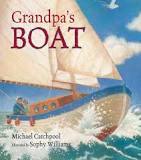 Grandpa’s Boat
(by Michael Catchpool and Sophie Williams; Andersen Press): Sometimes, you need to mend broken memories frozen in time to allow the process of healing to begin. Holding on to these trap those left to grieve the loss in a poignant cage of despondency and hopelessness. The family in this book must repair the dead Grandpa’s boat and sail in his sea-steps to finally let go of their grief.
Grandpa’s Boat
(by Michael Catchpool and Sophie Williams; Andersen Press): Sometimes, you need to mend broken memories frozen in time to allow the process of healing to begin. Holding on to these trap those left to grieve the loss in a poignant cage of despondency and hopelessness. The family in this book must repair the dead Grandpa’s boat and sail in his sea-steps to finally let go of their grief. Picture of Grace
(by Josh Armstrong and Taylor Bills): Little Grace loses her artist grandfather with whom she has shared a special strong bond (‘Grace was Grandpa Walt’s biggest fan’; ‘Grace understood the word “perfect” completely: It described every moment spent with her grandfather’). The book shows some spirited conversations between them, the kind that every grandchild enjoys with a grandparent. Grace’s loss, therefore, becomes all the more relatable. But what is easily the most memorable bit of this book is the how Grace decides to celebrate and honour her grandpa’s life and play back the ‘perfect’ world that he meant for her, and she for him.
Picture of Grace
(by Josh Armstrong and Taylor Bills): Little Grace loses her artist grandfather with whom she has shared a special strong bond (‘Grace was Grandpa Walt’s biggest fan’; ‘Grace understood the word “perfect” completely: It described every moment spent with her grandfather’). The book shows some spirited conversations between them, the kind that every grandchild enjoys with a grandparent. Grace’s loss, therefore, becomes all the more relatable. But what is easily the most memorable bit of this book is the how Grace decides to celebrate and honour her grandpa’s life and play back the ‘perfect’ world that he meant for her, and she for him. A Mama for Owen
(by Marion Dane Bauer): Tragedies happen in real life, they do. The ones with hope in their heart always manage to find comfort in strange ways. A baby hippo’s search for his mother swept away in tsunami brings him to an unusual mama. The book doesn’t overtly talk about the mommy hippo’s death, but the loss for the baby is just as monumental.
A Mama for Owen
(by Marion Dane Bauer): Tragedies happen in real life, they do. The ones with hope in their heart always manage to find comfort in strange ways. A baby hippo’s search for his mother swept away in tsunami brings him to an unusual mama. The book doesn’t overtly talk about the mommy hippo’s death, but the loss for the baby is just as monumental. Harry and Hopper
(by Magaret Wild and Freya Blackwood; Feiwel and Friends): A beautifully told and illustrated story of a boy being subconsciously in a state of denial, and the gradual acceptance, of his dog’s sudden death.
Harry and Hopper
(by Magaret Wild and Freya Blackwood; Feiwel and Friends): A beautifully told and illustrated story of a boy being subconsciously in a state of denial, and the gradual acceptance, of his dog’s sudden death.Richa Jha is a picture book enthusiast and author and the founder of Pickle Yolk Books.
August 21, 2015
Sandhya Renukamba’s lifelong affair with picture books
#nevertoooldforpicturebooks is a no-holds-barred invitation to one and all to make this hashtag a zingy buzz. Anything, just about anything from anyone reinforcing that one is never too old to dig with joy into a picture book is welcome here. The very first straight-from-the-heart note goes out from the incurable bibliophile, blogger and freelance writer, Sandhya Renukamba. Humongous picture booky hugs for this, Sandhya; it’s over to you now:
One of the best children’s books, Alice in Wonderland, begins thus:
Alice was beginning to get very tired of sitting by her sister on the bank, and of having nothing to do: once or twice she had peeped into the book her sister was reading, but it had no pictures or conversations in it, `and what is the use of a book,’ thought Alice `without pictures or conversation?’
Which makes sense. Most of the time. Even after a child graduates beyond needing pictures in books, an illustrated edition of a book is so much more attractive than a non-illustrated one. And conversations – nothing like conversations in a book to spice up the narrative. Any reader – grownups too – will agree with that!
So yes, picture books. It all began when the daughter was born. I have been a lifelong reader, but when I was a child, there were hardly any picture books around. At least not the kind of books we get today. It was while discovering reading children’s books along with my daughter that I first fell in love with picture books. And we have not looked back since.
The happiest times I have spent as a mother were reading aloud to my daughter. When she was very little, we lived in the UK. This meant, for readers like us – we all are big readers in the family – it was quite the Promised Land. The first thing we did after finding a house and settling in, was to get a library card. It was the best thing I have ever done.
Our very first picture books together were the likes of The Very Hungry Caterpillar, Peter Rabbit books, Guess How Much I Love You, Are You My Mother?, The Going-to-bed Book, and This Is The Bear. I would often ‘read’ the stories to her in our native tongue, along with reading them out in English. As she grew older, we visited family stories with books like Tell Me a Story, Mama, and When I was a Little Girl. Angry times were handled with the likes of Where The Wild Things Are. An early introduction to poetry and rhymes was made with books like Over In The Meadow and Iza Trapani’s retellings of nursery rhymes like Itsy bitsy spider, Mary Had a Little Lamb, and The Bear Went Over the Mountain. Wackilicious times were spent with the books of Dr Seuss, Edward Lear, and Shel Silverstein, many of which are layered enough to be picked up over and over again, well into adulthood.
We learnt much about India in books like Handmade In India, Excuse Me, Is This India?, I Is For India, We, The Children Of India: the preamble to our constitution, and Going To School In India. In fact, the wonderful picture books by Tulika books, Pratham books, Katha books, Tara books, etc., are all part of our journey – there are too many wonderful books to enumerate. For example, conversations about diversity were seeded with books like Same & Different, I Am Different, and We Are Different, all by Manjula Padmanabhan.
The Amelia Bedelia were the best introduction to the pun, humour that I think is of the highest order. With our growing book collection, books overflowing everywhere, and probably the only decoration at home, Sarah Stewart’s The Library was the perfect book to go to. Loss was handled with gentleness with the help of books – Robie H Harris’s Goodbye Mousie the perfect book when the daughter’s goldfish died, and Tear Soup the book we turned to when she lost a much loved cousin recently.
A recent addition to our collection is Neil Gaiman’s Blueberry Girl, and The Book With No Pictures. Yes, I know what Alice said about books with no pictures, but believe me, this is one book you’d want to pick up. And wordless books? They are the best kind of picture books. I promise you that if you pick up Raymond Brigg’s The Snowman, or Barbara Lehman’s The Red Book, Mercer Mayer’s A Boy, A Dog, and A Frog, or Shaun Tan’s The Arrival, or David Wiesner’s Tuesday, or Jeannie Baker’s Home, or any similar books, you’ll have a treasure in your hands that can be timeless, and can be ‘read’ by little ones unable yet to read, as well as be layered enough for teenagers and even adults. And this one, The Mysteries Of Harris Burdick, has to be picked up to be believed!
I could clearly go on and on. Even today, when we visit bookstores, our purchases are never complete without at least one picture book added to the mix. After all, one never grows out of picture books, no matter how old one gets. They are our first step into reading purely for pleasure, but they also are an education. In many ways. One can even charm non-readers with picture books, luring them into the world of readers as they get hooked. As said in the opening lines in Lauren Child’s well-loved picture book Who’s Afraid Of The Big Bad Book?
‘Herb loved storybooks. Although he wasn’t a very good reader, it didn’t matter because he could tell a lot from the pictures.’ 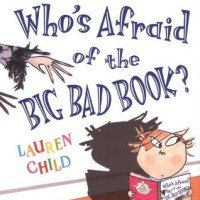
August 3, 2015
My Space, My Body
Story: Roopa Pai
Illustration: Archana Sreenivasan
Published by: GAIT
If you lay your hands on the siblings Taka-Dimi starrer My Space, My Body, do not make the mistake (as I did) of jumping straight to the story before reading the note to the parents. For in it lies the blueprint for extracting the maximum you can from this lovely illustrated story book.
The book is there for a purpose. It is the first in the series developed as a resource material for children enrolled with GAIT (Grooming Artistic Innovation and Talent), a niche player in the field of creative movement in education. It aims to bolster a reader’s understanding of her own body and how it can be used as a tool to express herself – through music, dance, theatre, and creative movement where the body itself, more than the words, becomes the medium of expression.
The two stories in this book handle subjects that even adults find difficult to make sense of – personal space and body awareness. As concepts, both work in tandem, as an understanding of one would lead to an acute awareness of the other, whether in its use or its violation. And so, I was happy to see both these tricky subjects being addressed in the same book. Indeed, the world we inhabit would be a far gentler, happier, more hospitable place if people were to try and understand the basics of personal space. Also, the more at ease we get with our physical bodies, the more it frees up our minds.
Roopa Pai excels, as always. The crisp slice-of-life dialogues make the pages believable, real and full of warmth. And oodles of fun too. We all have a Taka or a Dimi or the Mama or the Puppa in our homes. The pages throw enough relatable every day vignettes of a pair of siblings (squabbling, loving, sharing, inquisitive, et al) to make the kids feel one with them. As parents, we are always confronted with the task of explaining difficult intangibles in a way that leaves a lasting impression on them. I loved the idea of introducing the concept of an invisible bubble in ‘Take-Dimi Win The Game’ surrounding each of us that pops when personal space of others or oneself is disregarded. Don’t we all love popping bubbles?! The trick is in training our minds to not do so at the cost of another person’s bubble (read, personal space). In ‘Taka-Dimi At The Zoo’, it takes the siblings a visit to the local zoo to appreciate that ‘I think I’m happy just the way I am.’
Archana Sreenivasan’s endearing, playful, vibrant illustrations are a sure winner in this handsome hardcover. The two double spreads that extend as fold-outs at the end of each story are brilliant in their detail. The first one is my favourite; each time I look at it afresh, I discover something new. Other engaging activities also follow the stories. And then there is the adorable pet cat that breezes in and out of the frames (in the first story) – the kids are sure to love her.
My Space, My Body will engage a young mind in ways more than one. Read it often to or with your kids to enable them to be more aware of their bodies, selves, of the spaces around them. And read it often also to keep them fascinated with their bodies and see them grow into confident happy beings. The back cover blurb puts it beautifully:
‘As we become better with words, we become more stilted in our movements, more uncomfortable with our bodies, and more constrained in our expression.’ A positive body image is one of the strongest tools you can arm your child with.
Click here to learn more about the GAIT program.
June 20, 2015
Sleep Like A Tiger
Published By: Houghton Books For Children
Story: Mary Logue
Illustrations: Pamela Zagarenski
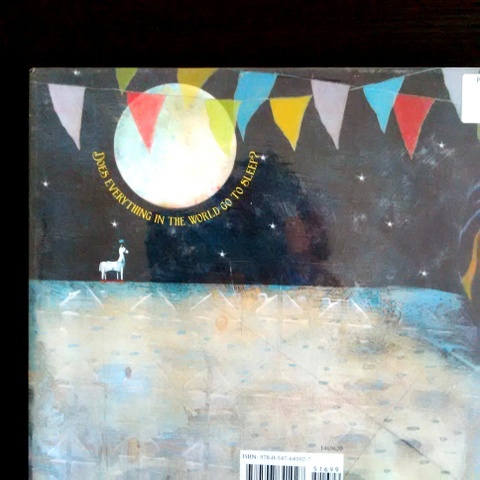
In a Sentence: Why must we have to sleep, at all?
What is it About: It’s time for bed, but the little girl doesn’t want to go to sleep. The princess is not tired, of course, as no self-respecting kid ever is. We see her having to go through the winding down bed time rituals, all the same. And again, once tucked in bed, she asks questions, of course, as any self-respecting kid must. She wants to know if everything in the world goes to sleep. Her parents tell her, as all (well, most, who’re already not struggling along the fine border between sanity and insanity by then) do, as lucidly as they can, whatever they know. But the question-barrage continues, as it must. What about Bats? Snails? Whales? Bears? Phew!
Do her questions end? Does she finally fall asleep? Grab this utterly beautiful book to find out!
Form and language: If prose were poetry, it’d be something like this. Sample this:
‘The little girl’s bed was warm
and cozy,
a cocoon of sheets,
a nest of blankets.’
Can it get more beautiful than this?

What makes it snuggly: It’s just the whole cozy, fuzzy, warm and snug feeling page after page. The text flows as gently as the dreamy illustrations that both soothe and blow your mind off (it’s a Caldecott Honor Book, after all!). And then the majestic mighty beast of the wild, the tiger (with its crown, to boot) seen in a most loving, tame, mild form – snoozing, cuddling a soft toy, and the little girl tucked in by its side.

What Stands Out: For me, besides the subtle humour, it’s the remarkably cool and patient parents whose reply to a ‘I’m still not sleepy’ is a calm ‘We know. You can stay awake all night long.’!  Or perhaps, it comes from years of being king and queen!
Or perhaps, it comes from years of being king and queen!
Will be best enjoyed by: 2+
Love Ratings (0-5)?
Ha Ha! Quotient: 4
Touches the heart: 5
Cuts through the clutter: 5
Visual appeal: 5
Encore Quotient: 5
Thank God it’s not moral science: 5
Show, don’t tell: 4
Hey, this is a really important book!: 4
September 16, 2014
A Mummy for Owen – Goodreads review
For some reason, Goodreads no longer lets the body of the review show up here. Please click on the book title for the link.
February 13, 2014
Endangered Animals of India
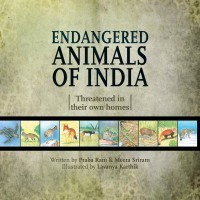 Published By: Mango (DC Books)
Published By: Mango (DC Books)
Words: Praba Ram and Meera Sriram
Illustrations: Lavanya Karthik
Rs 245
I am back with some delicious book chat after a long long time and it’s not even about a picture book! Holler holler, run for cover?! Please don’t (!), because the book I have here is one that each of us should try and lay our hands on: Endangered Animals of India – a wonderfully satisfying treat from two of the most sensitive children’s book authors amidst us – Praba Ram and Meera Sriram (this is the fourth book they have co-authored).
This no-fuss book is divided into seven sections covering the vast diversity of Indian’s geographical relief and the corresponding natural habitats. It features ten endangered and critically endangered animals from these regions and talks about everything that you would ever want to know about them, including, naturally, how we are responsible for getting them to the brink of extinction.
This book is PACKED with trivia too, like why dholes are called whistling dogs, or that the Malabar civets have never been seen on trees, or – oh c’mon, I am not going to give it all away! 
The tone is light, breezy and easy, and conversational at places:
“An inner fur layer with short hair keeps them warm in the chilly waters, while an outer glossy layer is striped or spotted. A shiny snug-fit perfect for a catwalk you’d think!”
And if I may tell you the most awwww! moment of the book, it’s this:
“Let’s leave him (guess!) alone, so he can be around longer – some trees to hang out and bamboo to eat are all he needs!”
The animal-skin textured look of the paper used couldn’t be more suited to a book like this. Lavanya Karthik’s gorgeous illustrations done in simple colour pencil (or is it crayons) hues are incredibly life-like. Remarkably well done as they are, they look both sublime and disturbing at the same time, considering that some of these beautiful animals may not be around for us to see in future, if we don’t act now. Just look deep into the eyes of the black bug and you’ll see what I mean; they speak back to you. I wish we had more illustrations in the book (you’ll really be left begging for more).
The book touches upon the various factors that have led to the decline in the numbers of these animals – deforestation, poaching, human greed, urbanization, reducing grasslands, or, as in the case of the snow leopard, even a decline in the numbers of prey available to feed on. I was happy to see the authors mention the cases of celebrities involved in hunting black bucks; references like these throw up options for many discussions with our children around how unconsciously or at times through our willfully callous acts, we humans upset the very delicate balance in the food chain and the ecosystem. And how our actions jeopardize our own future too (as the book explains in the context of pygmy hogs, for instance):
“Preserving these grasslands is equally important to us. They absorb excess rainwater and help control floods in the forests. Being a vulnerable lot, loss of habitat affects these hogs much more than any other animal living in the same habitat. So, when their numbers dwindle, the pygmy hogs are actually sounding an alarm to save all diverse life forms of that ecosystem. So, we better keep counting!”
For me the most poignant sentence in the book was this when I came to the word ‘extinct’:
“One of the swiftest land mammals, the black bucks can even outrun their natural predator, the extinct Indian cheetah.”
A dismaying reality check of what we have done, what we’ve allowed to happen, and what we continue to do to so many other precious spokes in our ecosystem with rampant disregard. And as author and reviewer Artnavy points out in her review about the sub-title of the book, on Saffron Tree,
“Threatened in their own home” reads the sub- title. It is indeed saddening that there is need for such a book- that nature’s beautiful creations do not feel secure in their own homes.”
Praba and Meera’s depth of research (a large bulk of it from the IUCN, as the authors point out in the introduction, which, btw, is lucidly written. If you have time for just a couple of pages, let it be the introduction) and details takes the reader right to the scene of action. Sample this gentle and poised description:
“She slides on her belly and hauls herself awkwardly. She waits on the sandy bank for her baby to creep out of the nest. With jaws too narrow to carry her newborn, she gently nudges it towards the water.” (Guess, again, which animal! Guess, guess guess!)
If it’s sensitizing your child that you’re seeking, this book has enough fodder to keep a young mind engaged for hours and enlightened for life. If it’s information you want your child to add to her knowledge bank, this book will not disappoint.
Oh. And I bet you didn’t know that gharials pose absolutely NO threat to humans, right?! One more reason to grab a copy of this book: to be better informed about the ecosystem which we are a part of, but for which we often forget our critical role in nurturing, maintaining and restoring its lost (and losing) balance.
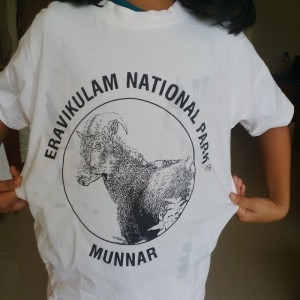
Leaving you with this excerpt from the section on the Nilgiri tahr (because my daughter here proudly shows off her much-loved tshirt):
“…around a thousand are in the Eravikulam National Park of Kerala alone. Tourists flock the area to capture images of the tahr standing fearlessly along those rocks, against dense fog and mist. This enchanting sight gives it a local name, ‘cloud goat’! Conservationists often remind forest officials and tourists to respect protective measures, especially in national parks.”
Makes me look back on our visit to the park and reflect on whether we acted responsibly there or not. I think we did. We always do. 
p.s – this book will be an invaluable resource for your child’s school project on endangered animals, if that’s what you want most from a book! 




